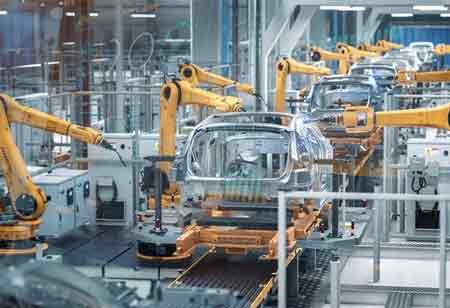

Thank you for Subscribing to Auto Business Outlook Weekly Brief

Automation accelerates production, minimizes errors, and enhances workplace safety.
The automotive industry is undergoing a transformative phase, with technological advancements shaping the future of auto parts manufacturing. Auto parts production is becoming more efficient, high-quality, and sustainable as vehicles become more complex and consumer expectations rise. The use of 3D printing has revolutionized auto parts manufacturing. It allows the creation of robust and lightweight components with improved performance. Manufacturers can quickly produce prototypes and low-volume parts, reducing lead times and costs. 3D printing enables the development of intricate objects that are impossible using traditional methods. The demand for lightweight and durable materials drives the adoption of advanced materials in auto parts manufacturing. High-strength alloys, composite materials, and carbon fiber-reinforced polymers are increasingly used to reduce vehicle weight and improve fuel efficiency. The materials also enhance safety and contribute to the vehicle's overall performance. Robotics and automation are essential for modern auto parts manufacturing. Robotic systems are employed for welding, painting, and assembly, improving precision and efficiency. Collaborative robots, or cobots, work alongside human operators to enhance productivity and streamline manufacturing processes. Integrating IoT and Industry 4.0 technologies allows for the creating of smart factories in the automotive sector. Connected sensors and devices gather real-time data, enabling manufacturers to monitor equipment performance, optimize production processes, and predict maintenance needs. The data-driven approach enhances overall efficiency, reduces downtime, and improves the quality of auto parts. AI and machine learning are transforming auto parts manufacturing through predictive maintenance, quality control, and demand forecasting. Data analytics algorithms identify patterns and anomalies, enabling manufacturers to predict when equipment might fail, optimize production schedules, and ensure consistent product quality. AR and VR technologies are used in auto parts manufacturing for training, maintenance, and design purposes. Employees can receive virtual training on complex assembly tasks, reducing the learning curve and improving skill development. AR assists in maintenance tasks by providing real-time information on equipment status and guiding technicians through repair procedures. In design, VR allows engineers to visualize and evaluate prototypes in a virtual environment before physical production. The technologies contribute to increased operational efficiency and cost savings. Digitalization of the supply chain is becoming increasingly crucial in auto parts manufacturing. Technologies such as blockchain enhance transparency, traceability, and security in the supply chain. It ensures that manufacturers can track the origin and authenticity of components, reduce the risk of counterfeiting, and optimize inventory management. Auto parts manufacturers are prioritizing sustainability by adopting eco-friendly practices and materials. It includes recycling and reusing materials, reducing waste, and implementing energy-efficient processes. Sustainable manufacturing aligns with environmental concerns and meets consumers' and regulatory bodies' growing demand for eco-conscious products. The automotive industry's evolution in auto parts manufacturing extends beyond technological trends to encompass a shift in business models. Original Equipment Manufacturers (OEMs) are increasingly exploring partnerships and collaborations with tech companies and startups to leverage expertise in emerging technologies. The collaborative approach fosters cross-industry innovation, ensuring a holistic integration of cutting-edge solutions into auto parts production. The emphasis on circular economy practices is gaining traction, with manufacturers exploring closed-loop systems and circular supply chains. The holistic strategies address environmental concerns and promote resilience, responsiveness, and adaptability in the dynamic landscape of auto parts manufacturing, setting the stage for a sustainable and innovative future. Auto parts manufacturing in the automotive industry is witnessing a significant shift driven by technological advancements and changing market demands. Additive manufacturing, advanced materials, robotics, IoT, AI, AR, VR, supply chain digitization, and sustainability initiatives are key trends shaping the future of auto parts production. Manufacturers that embrace these technologies stay competitive and contribute to the evolution of a more efficient, agile, and sustainable automotive industry. The auto parts manufacturing landscape will likely see further innovation and transformative changes.I agree We use cookies on this website to enhance your user experience. By clicking any link on this page you are giving your consent for us to set cookies. More info